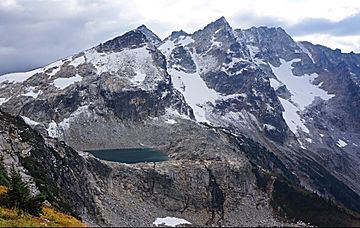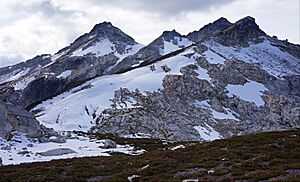Cirque Mountain (Washington) facts for kids
Quick facts for kids Cirque Mountain |
|
|---|---|

Northeast aspect, with Triad Lake
|
|
| Highest point | |
| Elevation | 7,966 ft (2,428 m) |
| Prominence | 246 ft (75 m) |
| Isolation | 2.3 mi (3.7 km) |
| Parent peak | Napeequa Peak 8,073 ft |
| Geography | |
| Location | Glacier Peak Wilderness Washington, U.S. |
| Parent range | North Cascades Cascade Range |
| Topo map | USGS Clark Mountain |
| Geology | |
| Age of rock | Cretaceous |
| Type of rock | Granodiorite |
Cirque Mountain is a tall mountain in Washington state. It stands about 7,966 feet (2,428 meters) high. You can find it in the Glacier Peak Wilderness, which is part of the North Cascades mountain range.
This mountain sits right on the top of the Cascade Range. It's on the border between Snohomish County and Chelan County. It also marks the edge of two big forests: the Mount Baker-Snoqualmie National Forest and the Wenatchee National Forest.
Cirque Mountain is part of a group of peaks on Chiwawa Ridge. Its closest taller neighbor is Napeequa Peak, which is just a short distance south. Other cool peaks on this ridge include Fortress Mountain and Buck Mountain.
The western side of Cirque Mountain rises very steeply. It goes up 4,000 feet (1,219 meters) from the Suiattle Valley in only about 1.5 miles (2.4 km). This mountain has small, unnamed glaciers. These glaciers are found in bowl-shaped areas called cirques around the top of the mountain. Water from rain and melting ice flows from the mountain. It either goes east into the Napeequa River or west into the Suiattle River.
Contents
How Cirque Mountain Was Formed
The North Cascades are known for their rugged look. They have sharp peaks, long ridges, and deep valleys carved by glaciers. These amazing shapes and big changes in height were created by geological events over millions of years. These events also led to different climates across the Cascade Range.
Ancient Earth Movements
The Cascade Mountains started forming millions of years ago. This was during a time called the late Eocene Epoch. The North American Plate (a huge piece of Earth's crust) was slowly moving over the Pacific Plate. This movement caused many volcanic eruptions.
Also, small pieces of Earth's crust, called terranes, crashed into North America. This helped create the North Cascades about 50 million years ago.
Ice Ages and Shaping the Land
Later, during the Pleistocene period, which began over two million years ago, glaciers played a huge role. Giant sheets of ice moved forward and then retreated many times. As they moved, they carved and shaped the land.
Glaciers were most widespread about 18,000 years ago. Most valleys were free of ice by 12,000 years ago. The land was also pushed up (a process called uplift) and cracked along fault lines. These forces, along with glaciation, created the tall peaks and deep valleys we see today in the North Cascades.
Volcanic Neighbors
Tectonic activity in this area started about 90 million years ago. A lot of volcanic activity began about 35 million years ago. Glacier Peak, a large volcano, started forming in the middle of the Pleistocene period. It's only about 6.5 miles (10.5 km) west of Cirque Mountain. Because Glacier Peak is so close, you can often find volcanic ash in the area around Cirque Mountain.
Weather at Cirque Mountain
Cirque Mountain is in a marine west coast climate zone. This means it gets a lot of moisture from the ocean. Most weather systems start over the Pacific Ocean. They then travel northeast towards the Cascade Range.
How Mountains Affect Weather
When these weather systems reach the North Cascades, the tall mountains force the air upward. This process is called Orographic lift. As the air rises, it cools down and drops its moisture. This moisture falls as rain or snow onto the Cascades.
Because of this, the western side of the North Cascades gets a lot of rain and snow. This is especially true during the winter months.
Winter and Summer Weather
In winter, the weather is usually cloudy. But in summer, high-pressure systems over the Pacific Ocean become stronger. This often leads to clear skies with little or no cloud cover.
Because of the ocean's influence, the snow in this area tends to be wet and heavy. This can create a high risk of avalanches, so it's important to be careful when visiting in winter.




